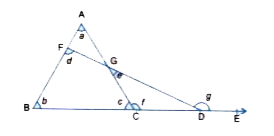If U={a,b,c,d,e,f,g,h}, find the complements of the following sets :(i) A={a,b,c} (ii) B={d,e,f,g] (iii) C={a,c,e,g} (iv) D={f,g,h,a)
To find the complements of the given sets with respect to the universal set U={a,b,c,d,e,f,g,h}, we will subtract the elements of each set from the universal set.
1. Identify the universal set: U={a,b,c,d,e,f,g,h}.
2. Identify the elements in set A: A={a,b,c}.
3. Subtract the elements of A from U:
- Remove a,b,c from U.
- Remaining elements: {d,e,f,g,h}.
4. Therefore, the complement of A is:
A′={d,e,f,g,h}
(ii) Finding the complement of set B={d,e,f,g}
1. Identify the elements in set B: B={d,e,f,g}.
2. Subtract the elements of B from U:
- Remove d,e,f,g from U.
- Remaining elements: {a,b,c,h}.
3. Therefore, the complement of B is:
B′={a,b,c,h}
(iii) Finding the complement of set C={a,c,e,g}
1. Identify the elements in set C: C={a,c,e,g}.
2. Subtract the elements of C from U:
- Remove a,c,e,g from U.
- Remaining elements: {b,d,f,h}.
3. Therefore, the complement of C is:
C′={b,d,f,h}
(iv) Finding the complement of set D={f,g,h,a}
1. Identify the elements in set D: D={f,g,h,a}.
2. Subtract the elements of D from U:
- Remove f,g,h,a from U.
- Remaining elements: {b,c,d,e}.
3. Therefore, the complement of D is:
D′={b,c,d,e}
Final Answers:
- A′={d,e,f,g,h}
- B′={a,b,c,h}
- C′={b,d,f,h}
- D′={b,c,d,e}
2. Identify the elements in set A: A={a,b,c}.
3. Subtract the elements of A from U:
- Remove a,b,c from U.
- Remaining elements: {d,e,f,g,h}.
4. Therefore, the complement of A is:
A′={d,e,f,g,h}
2. Subtract the elements of B from U:
- Remove d,e,f,g from U.
- Remaining elements: {a,b,c,h}.
3. Therefore, the complement of B is:
B′={a,b,c,h}
2. Subtract the elements of C from U:
- Remove a,c,e,g from U.
- Remaining elements: {b,d,f,h}.
3. Therefore, the complement of C is:
C′={b,d,f,h}
2. Subtract the elements of D from U:
- Remove f,g,h,a from U.
- Remaining elements: {b,c,d,e}.
3. Therefore, the complement of D is:
D′={b,c,d,e}
- A′={d,e,f,g,h}
- B′={a,b,c,h}
- C′={b,d,f,h}
- D′={b,c,d,e}
Topper's Solved these Questions
- SETSBook:NAGEEN PRAKASHAN ENGLISHChapter:SETSExercise:Exercise 1.6
Explore 8 Videos
- SETSBook:NAGEEN PRAKASHAN ENGLISHChapter:SETSExercise:MISC Exercise
Explore 16 Videos
- SETSBook:NAGEEN PRAKASHAN ENGLISHChapter:SETSExercise:Exercise 1.4
Explore 12 Videos
- SEQUENCE AND SERIESBook:NAGEEN PRAKASHAN ENGLISHChapter:SEQUENCE AND SERIESExercise:Miscellaneous Exercise
Explore 32 Videos
- STATISTICSBook:NAGEEN PRAKASHAN ENGLISHChapter:STATISTICSExercise:MISCELLANEOUS EXERCISE
Explore 7 Videos
Similar Questions
Using the given diagram, express the following sets in terms of set A and B.

(i) {a,d} , (ii) {a,d,c,f}, (iii) {a,d,c,f,g,h}, (iv) {a,d,g,h}, (v) {g,h}
View SolutionLet A = { b,d,e,f }, B = { c,d,g,h} and C = {e,f,g,h} .Find :
C -A
View SolutionLet A = { b,d,e,f }, B = { c,d,g,h} and C = {e,f,g,h} .Find :
B-C
View SolutionLet U= {a,b,c,d,e,f,g} be the universal set and let its subsets be A = {a,b,d,e} and B = {b,e,g}
Verify that : (A∪B)'=(A'∩B')
View SolutionLet U= {a,b,c,d,e,f,g} be the universal set and let its subsets be A = {a,b,d,e} and B = {b,e,g}
Verify that : (A∩B)'=(A'∪B')
View SolutionLet A = { b,d,e,f }, B = { c,d,g,h} and C = {e,f,g,h} .Find :
A- B
View SolutionUse the given figure to express :
(i) a in terms of b and f,
(ii) e in terms of f and g,
(iii) d in terms of a and e,
(iv) c in terms of e and g.

View SolutionLet A = { b,d,e,f }, B = { c,d,g,h} and C = {e,f,g,h} .Find :
(B−C)∪(C−B)
View SolutionLet A = { b,d,e,f }, B = { c,d,g,h} and C = {e,f,g,h} .Find :
(A−B)∪(B−A)
View SolutionFind the area of the pentagon shown in Figure, if AD=10cm, AG=8cm, AH=6cm, AF=5cm, BF=5cm, CG=7cm and EH=3cm.
View Solution